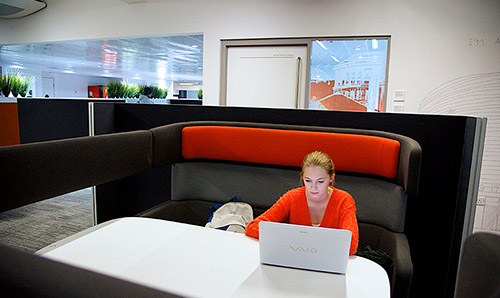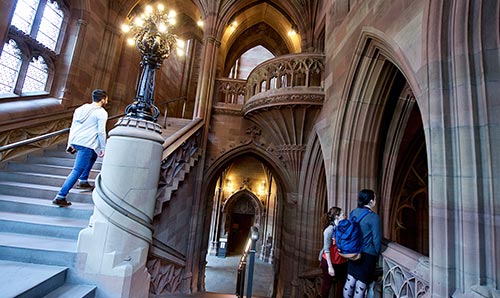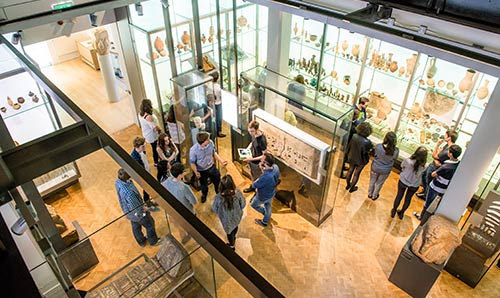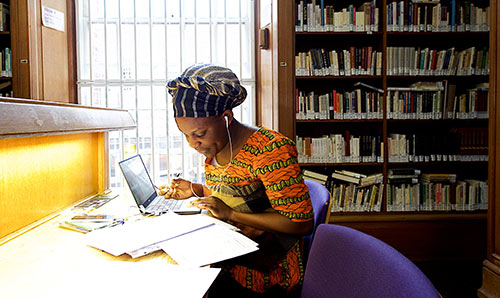Facilities
Our students have access to some inspirational study spaces, collections and resources.
Field survey equipment
Archaeology has a full range of equipment to support fieldwork. This includes:
- a Phantom drone and GoPro camera;
- a sub-metre GPS survey system;
- compact and DSLR cameras;
- photogrammetry equipment and software;
- three total stations and a traverse kit.
Geophysics is supported with several instruments, partly funded by the Your Manchester Fund. This includes:
- Bartington Grad601 Single Axis Magnetic Field Gradiometer System;
- Geoscan RM85 resistivity survey equipment, with a range of probes;
- TR Systems CIA resistivity survey equipment, with a range of probes.
Several of our laboratory-based pieces of equipment can also be used in the field. These include the PXRF instrument, the ProScope, and the 3D scanner.
Laboratories
Large Laboratory
There is a large laboratory used for teaching and coursework, particularly within:
- ARGY10501: Introduction to Archaeological Practice;
- ARGY20502: Fieldwork, Practice and Interpretation;
- ARGY30361: Material Culture.
Research is carried out in a separate laboratory, which a wide range of capabilities.
The Archaeology laboratories are overseen by Dr John Pipriani, Laboratory Technician.
Laboratory for Archaeological Research
This consists of a general research laboratory and a secure laboratory. There is a range of subsidiary facilities.
3D recording and printing
3D recording uses either a benchtop laser scanner or photogrammetry software (Agisoft Photoscan).
Two 3D printers have recently been acquired. Their potential for teaching materials, in particular, is being explored.
Microscopy
There is a range of optical and petrographic microscopes. Thin section preparation facilities are available elsewhere within the university.
Photography
We have two professional copy stands, lighting and digital cameras. These get extensive use for research and undergraduate projects.
XRF laboratory
We use a portable XRF instrument (a Niton XL3t 980 GOLDD+ instrument) for a range of projects.
- Ceramic analysis, in development, with work started or planned on material from southern Iraq, Turkey and the Aegean.
- Metal analysis, currently being used on material from Tell Khaiber in southern Iraq and historical metalwork from Australia.
- Multi-element soil survey, including systematic, multi-season programmes of research at Dorstone Hill and Tell Khaiber.
- Obsidian source analysis, mainly of Near Eastern obsidian, although it has also been used on obsidian from Rapa Nui and Egypt in the collections of the Manchester Museum. An extensive set of international standards are used in a custom calibration for this work.
- Stone provenance analysis, another development area with work associated with PhDs on material from Cyprus and southern England.
Wet sieving and floatation
This is a routine aspect of systematic retrieval of archaeological remains. Full facilities are present in the laboratory.
Libraries and collections
Art History and Archaeology Library
Archaeology also shares a disciplinary library with Art History.
We keep the most used books in this library for reference.
It provides a pleasant and quiet working environment for students.
The library is 'reference only' during the week. However, you can take books out over the weekend, from 2pm on Friday until 10.30am on Monday.
Classics and Ancient History Reference Collection
The Classics and Ancient History Reference Collection is in the Samuel Alexander Building. All members of the School are welcome to use the room and its resources. Classicists and Ancient Historians will be particularly interested in its holdings. This reference collection comprises around 2,200 volumes, including Greek and Latin:
- dictionaries;
- reference works;
- texts;
- translations;
- works of modern scholarship.
The collection has been built thanks to generous gifts and bequests, and University Library funds.
In 2001, the collection was amplified with books from Keele University's Departmental Library. More recently, the ancient historical holdings of the Philip Haworth Library have also been transferred.
Teaching collections
We also have an extensive teaching collection of:
- artefacts;
- artefact replicas;
- ecofacts;
- human and animal remains.
Our teaching collections include the diverse, eclectic and extensive Brice Collection. This has everything from 20th-century coins, to middle Palaeolithic lithics. The Collection comprises material from almost every part of the world. It includes a selection of geological examples as well as experimental glass knapping.




